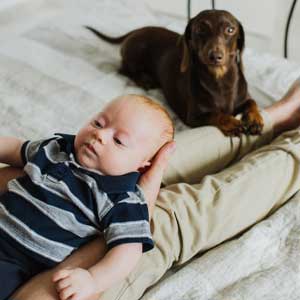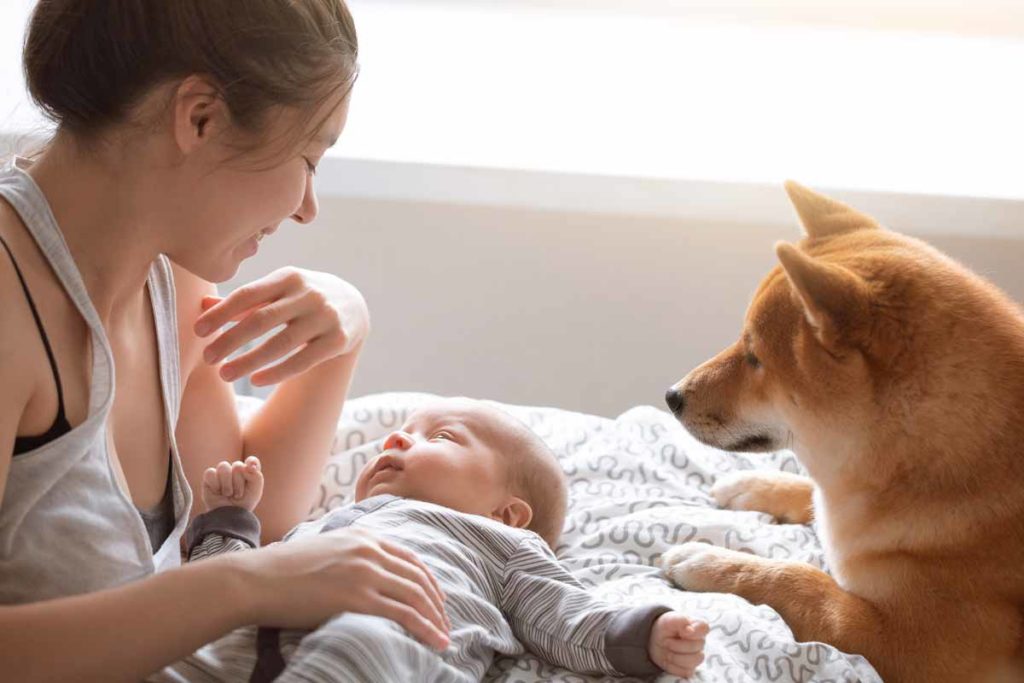One of the most significant life changes you may experience with your dog is the addition of children to your family. Dogs often become their baby’s playmate, protector, and best friend, and this bond can be one of the most beautiful things to watch.
Bringing home a new baby can introduce a lot of big changes for your dog, particularly if they were previously an “only child.” What potential challenges should pet parents be aware of when expecting a new baby? How can you set up your household for pet-baby success?
Table of contents
- Benefits of pet ownership
- Potential risks
- Plan, prep, and plan some more
- How to make a good first impression
- Long-term success
- What not to do
- Take home message
Benefits of pet ownership
Family pets can bring a lot of joy and love to a household. Pet ownership also teaches children valuable life skills like responsibility, trust, compassion, respect, and patience, notes Michigan State University. Kids can be excellent playmates for high-energy dogs. Both children and pets benefit from the extra love and affection they can provide for one another.
The companionship dogs offer humans is why we love them so much. Their natural pack mentalities, as well as the guarding and herding instincts of some breeds, allow many dogs to develop a strong bond and protective relationship with their family. Babies and their family dogs often spend a significant amount of time together growing this loving bond. Always up for playtime and affection, babies and dogs often have a wonderful friendship.
A canine family member can also offer numerous health benefits to kids, particularly while the child is very young. According to research by Dr. Eija Bergroth, infants who have pets in their household are less likely to get sick and develop both allergies and asthma later in life than children who live in a pet-free environment. Studies found that exposure to pet dander, as well as the microbes that pets carry into the home from outdoors, could prime babies’ still-developing immune systems and train them early to fend off common allergens and illnesses.
Additionally, Dr. Bergroth found that babies who grow up in homes with pets are 44 percent less likely to develop an ear infection and 29 percent less likely to receive antibiotics, compared with pet-free babies. This is important because overuse of antibiotics is known to encourage drug-resistance in bacteria, making infections more difficult to treat. So, when your mother-in-law scolds you for letting your dog lick your infant’s fingers and toes, rest assured that some germs can benefit your baby’s developing immune system.
Potential risks
The unpredictability of dogs and babies can make them a potentially dangerous combination. It is impossible for your dog to anticipate the unusual sounds and random movements your young child makes. These sudden stimuli can trigger fear in your dog, and a fearful dog can quickly become an aggressive dog. Dogs can pose potential hazards to children and babies, particularly if they exhibit:
- Any aggressive behavior from your dog towards family members, strangers, or other animals
- Anxious of fearful behavior
- “Rude” behavior such as knocking into people, jumping, or door dashing
- Rough play that involves biting or clawing
It is important to note that dogs are more likely to become stressed and display aggressive behavior if they can sense stress from the people around them. Staying calm can go a long way towards ensuring a positive pet-baby interaction. Know your dog’s limits and avoid putting them in highly stressful situations or expecting more than they are capable of. Rescue dogs in particular may need downtime to relax away from the baby, so set your dog up for success.
Plan, prep, and plan some more
You want to keep the peace in your home and make sure both your new baby and fur baby are safe and happy. It is important to prepare your dog for all the changes that a new baby will bring to avoid any negative interactions. Creating positive associations for your dog early on can lead to a lifelong companionship with your kids.
Do not wait until the baby arrives to help your dog adjust to the newly expanded family. You can lay a strong foundation for your dog’s relationship with your baby during pregnancy.
Behavior
The American Humane Association recommends owners learn about how their dog responds in common situations like walking with a stroller. You may want to enroll your dog in a basic obedience class to practice some baby-friendly manners. These classes can help address problematic behaviors like jumping greetings and leash pulling. Mastering basic commands like sit, stay, and go away can be very helpful when you are busy with an infant. The New York Times notes that how far in advance you should start to practice these skills depends on the severity of your dog’s undesirable behavior.
New sights, smells, and sounds
Early exposure to the wide variety of sounds, smells, behaviors, and equipment that come with a new baby will help your dog become comfortable with these changes. Animal behaviorists often recommend parents walk around the house rocking and cooing at a doll or a bag of flour wrapped in a blanket. The Animal Humane Association also notes that setting up the nursey in advance and bringing the stroller on daily dog walks can also help desensitize your dog. Play YouTube videos of crying babies and ask a fellow parent friend if your dog can meet their toddler in a controlled, supervised setting. Practice makes perfect!
Routine
Dogs thrive on routine and can easily become stressed with even minor changes. Expectant parents should try to minimize the number of changes that their pets have to experience at once. Perhaps the most difficult change for pets when their parents bring home a baby is the decrease in physical and verbal contact. Take note of how much affection and attention you give your dog throughout the day and gradually decrease it, as you will soon have your hands full with your baby. Just as you prepare them for the amount of attention they can expect when your baby arrives, make small, gradual adjustments to your dog’s daily schedule to get them used to how life will look with a human sibling.
How to make a good first impression
First impressions are important. Your dog should have pleasant experiences with your baby right from the start. Before you even head to the hospital, make sure the people you ask to take care of your dog when your baby is born are beloved friends and family members. This helps to minimize your dog’s stress during this time of change.
When you’re in the hospital
While you are in the hospital, many experts recommend bringing items that smell like your baby home for your dog to freely and thoroughly investigate. Send someone home with a blanket or onesie so your dog can get familiar with your child’s smell before they come home.
When you get home
If possible, experts from Family Paws recommend having other people enter the house before the baby. This allows your dog to express their usual excitement for your return in a safe, low-stress way. Whoever holds the baby should greet the dog in advance, as well. Family Paws encourages owners to leash their dog when the baby comes in the house for the first time to ensure you are in complete control. Your dog can be introduced to the baby slowly and calmly once they have settled down from the initial excitement. This usually entails thorough sniffing and perhaps some gentle licks.
Stay calm
It is critical that you remain calm when supervising your dog’s interactions with the baby. Research by Anne-Sofie Sundman shows that dogs mirror the stress levels of their owners. If you are jumpy and on-edge when your dog approaches, they will pick up on these feelings and may become nervous as well. Speak in a soft, upbeat tone and avoid getting physically tense so that your dog knows that this little bundle is not anything to worry about.
Long-term success

Ensuring your dog and children have positive, loving relationships in the long run often requires time and patience. Particularly if you are bringing home an infant for the first time, taking baby steps to make gradual progress and encourage positive interactions and associations is essential. Reward your dog when they are calm and initiate good interactions with your kid.
Making sure that your dog respects your baby also requires that their own needs are met. Even with drastic schedule changes and more responsibilities with a new baby, your dog should always get ample exercise. Mental and physical stimulation will help them exert energy in positive ways, minimizing the risk of boredom and destruction around your children. Take time for daily walks and bonding with your beloved dog once the baby arrives to connect and help them adjust. Dogs can provide much-needed companionship during the early days of parenthood, so take advantage of opportunities to spend meaningful time together while also getting your dog and baby accustomed to one another.
Parents should also ensure that their children learn from an early age to respect the dog’s personal space. This includes making it clear that your dog’s crate, bed, and or food bowls are off-limits. Mutual respect will go a long way toward a healthy relationship going forward.
If at any time you are concerned about your dog’s behavior, consult a qualified dog trainer or animal behaviorist.
What not to do
Just as important as learning what to do when you introduce your dog to your new child is knowing what not to do:
- Don’t tranquilize – It is not a good idea to sedate your dog for their first meeting with your new baby. Being woozy and out of control is likely to make your dog even more stressed and on-edge.
- Don’t leave dog and baby unattended – Always supervise your dog and baby when they are together. The behavior of young children can be erratic and may irritate your dog.
- Don’t neglect your dog – Yelling at, punishing, and even ignoring your dog when they are around your baby can lead to your dog developing negative associations with your child. This can make them less likely to engage and bond with your baby, and more stressed when they do have to interact.
- Don’t panic – As previously mentioned, dogs are very attuned to our emotions and mental states. Being anxious about your dog around your baby can actually encourage them to be anxious as well.
Take home message
Welcoming a new baby into your family can be an incredibly joyous and stressful experience. While your children and family dog have the potential to form a loving bond, preparing your dog for all of the upcoming changes will help prevent fear and stress that can lead to aggression. Your pup will need time to adjust, so beginning the process of exposing them to new things and getting comfortable with new routines early is essential to setting the entire household up for success when the baby arrives. While it is a stressful time for everyone, staying calm will also be critical to ensuring pet-baby harmony.









